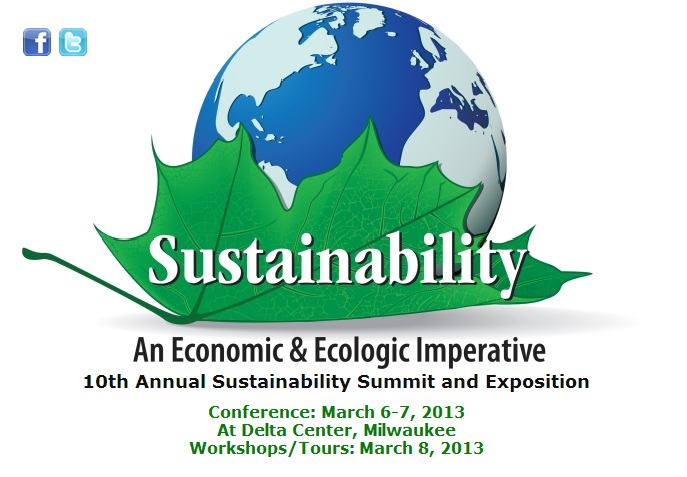by jboullion | Apr 1, 2013 | Uncategorized
The opinion piece below was published in the March 30, 2013 Milwaukee State Journal
A seismic shift occurred in the U.S. electric power industry this January. For the first time since the federal government began tracking new power plants, renewable energy sources – biogas, solar and wind – accounted for 100% of generating capacity added that month.
This milestone does not please fossil fuel interests, who are alarmed over the prospect of losing market share to clean energy. To reverse this trend, they have launched a national campaign involving the planting of so-called studies in selected states that falsely demonize renewable energy.
One such report, prepared by Beacon Hill Institute, a Massachusetts think tank that is openly hostile to pro-renewable energy policy,
surfaced in Wisconsin last week. Like all its other reports on state energy policy, the analysis is a heavy-handed attempt to reverse-engineer data points to fit the preordained conclusion and generate the headlines that the fossil fuel interests want to see.
An objective analysis would compare the cost of complying with Wisconsin’s modest 10% standard with all the other utility projects undertaken during the same time. But Beacon Hill’s analysis studiously avoids mentioning the new coal-fired power plants and pollution controls for old coal plants that are the primary cost drivers behind recent rate increases in Wisconsin. Utilities have dedicated over $5 billion to building or upgrading coal plants since 1999, dwarfing their investments in renewable generation. But you won’t find a word about that in this report.
You also won’t find any mention of the many new jobs, businesses and manufacturers leveraged by renewable energy standards in Wisconsin and other states. These include:
• Chilton-based DVO, which has become one of the leading designers and installers of farm-based biodigester projects in the nation.
• Milwaukee-based Helios, USA, which in just three years has become a supplier of competitively priced solar electric modules.
• Broadwind, whose Manitowoc facility now fabricates towers for windpower projects throughout the Great Lakes region.
It is not difficult to inventory the growth of Wisconsin’s clean energy supply chain from the ground up and determine how much of that was driven by state policy. A more rigorous study would have done so while providing evidence to support its contention that Wisconsin’s renewable energy policy caused a net reduction of jobs. In contrast, Beacon Hill relied on black-box computer models instead of phone surveys to reach its counterintuitive results.
As an economics professor once said to me: “If you torture your models enough, they will confess to anything you want them to.”
Had this been an intellectually honest effort, the study would have credited renewable energy policies for increasing income to farmers while providing millions of dollars’ worth of property tax relief to towns and counties. But that would have risked reaching the opposite conclusion: renewable energy policies here and in neighboring states have delivered tangible economic benefits to Wisconsin.
The false picture projected by this report crumbles when compared with the reality of Iowa’s energy experience. If renewable energy is so expensive, how does Iowa manage to generate 25% of its electricity from wind power while holding its rates 20% below Wisconsin’s rates on average? It’s worth pointing out that Mid-American, Iowa’s largest electric utility, is the largest owner of wind energy projects among all U.S. utilities, yet its electric rates remain in the single digits.
Yes, the fossil fuel interests are clearly worried, and they are resorting to outright disinformation such as Beacon Hill’s Wisconsin “study” to obscure the facts. Wisconsin’s renewable energy standard has indeed been an economic success.
Notwithstanding Beacon Hill’s efforts, voters like renewable energy and want to see more solar, bioenergy and wind powering Wisconsin’s economy. According to a bipartisan January 2012 poll, over 80% of voters sampled support policies requiring that 30% of Wisconsin’s electricity come from renewable sources.
If lawmakers are sincerely interested in economic growth, they should expand the standard beyond 10%.
Michael Vickerman is program and policy director of RENEW Wisconsin, a sustainable energy advocacy organization.

by jboullion | Feb 28, 2013 | Uncategorized
222 S. Hamilton, Madison, WI 53704
Immediate Release February 26, 2013
More Information
Don Wichert, Executive Director
608.255.4044, ext. 1
RENEW Petitions PSC to Improve Interconnection Rules
RENEW Wisconsin (RENEW) filed a petition on February 22 asking the Public Service Commission (PSCW) to simplify the process under which distributed generators can connect their generators to Wisconsin’s electrical grid. The vast majority of these small generating facilities are fueled with locally available renewable energy resources like biogas, solar, and wind.
RENEW’s filing grew out of a year-long study that assessed how Wisconsin’s 10-year old interconnection rule (PSC 119) compares with best practices established in other states.
“We found that Wisconsin’s outdated rules hurts distributed generators by adding complexity, time, and cost to the interconnection process ,” said Don Wichert, RENEW’s interim Executive Director and study coordinator. “Most of the renewable energy systems coming on line now are owned by non-utility generators. Fixing the problems in PSC 119 will lead to more renewable energy systems going in faster and at a lower cost. Supported by 86 companies, organizations, and individuals, RENEW’s petition identified 10 specific changes that, if adopted by the PSC, would align Wisconsin’s interconnection procedures with national best practices.
“Customer-owned renewable energy systems save ratepayers money in many ways”, said Wichert. “Because they offset electrical needs right where the electricity is being used, distributed renewables supply clean electricity in a reliable and affordable manner, avoiding potentially expensive investments in central generating plants and costly transmission lines. Moreover, they create jobs and support local businesses. These are all positive public policy goals”, Wichert said.
END
RENEW Wisconsin is an independent, nonprofit 501(c)(3) that leads and represents businesses, organizations, and individuals who seek more clean, renewable energy in Wisconsin. More information on RENEW’s website: www.renewwisconsin.org.
by jboullion | Feb 15, 2013 | Uncategorized
More on the Highland Wind Farm PSC decision: an article by Thomas Content of the Journal Sentinel:
State regulators on Thursday rejected an application to build a new wind farm in St. Croix County, citing concerns about turbine noise the project would generate for nearby homes.
The state Public Service Commission voted 2-to-1 to reject Emerging Energies’ proposal to build the Highland wind farm, which was proposed to generate 102.5 megawatts of power from 41 turbines, or eough to supply about 30,000 homes.
Commissioners said that they were rejecting the proposal “without prejudice,” in essence leaving the door open for the developer to file a new application for the project, after it conducts a new noise study using more conservative assumptions about the background noise in the area.
The $250 million Highland project is the first wind farm to be ruled on by the state commission since Republican Gov. Scott Walker appointed two commissioners, a majority of the three-member panel.
Emerging Energies representative Jay Mundinger said after the vote the developer plans to continue its pursuit of a permit for the project.
Commissioner Eric Callisto, the lone remaining appointee of former Democratic Gov. Jim Doyle, said he would have approved the project but would have attached conditions binding the developer to protect nearby landowners from excessive turbine noise.
Noise studies by the applicant found that 20 homes would experience noise levels above the 45 decibel standard at night, but the commission could work with the developer on “micro-siting” issues after new analysis was done, he said.
The Highland project is the only large wind energy project currently in active development in the state. The state’s utilities have already built enough wind farms to comply with the Wisconsin renewable portfolio standard, which requires that 10% of the state’s electricity come from renewable sources by 2015.
During the commission’s meeting in Madison, commissioner Ellen Nowak said the applicant didn’t prove that all the wind project would result in noise levels below 45 decibels at night, the standard that’s in Wisconsin’s wind siting rule.
As a result, she said she concluded the project was not in the public interest.
In their decision, the PSC commissioners decided not to attach special requirements concerning low-frequency noise, after wind consultants studied the impacts of low frequency noise from wind turbines the same developer built near Green Bay.
Reached after the meeting, Mundinger said Emerging Energies would take the commissioners’ noise concerns into account but was not giving up on the project.
“We believe that sound, from what we’ve heard, is a big concern, and we believe we can address that and we believe we have a pathway to get the (project permit) in short form,” he said. “We want to make sure we address the sound and be able to move this project forward.”
The company has offered not to use the kind of turbine that it used when developing the Brown County wind farm — the tallest towers built so far in Wisconsin. Instead, Emerging Emergies has agreed to use two other turbines that don’t generate as much sound, he said.
PSC commissioners said they would not approve the project if it used the loudest of the three turbines Emerging Energies had been considering.
“The turbines are better than ever before,” Mundinger said. “They’re quieter than the ones just 10 years ago.”
Peter McKeever, attorney for the Forest Voice, a group that mobilized in opposition to the wind farm,said he was pleased with the commission’s decision.
Wind farms are difficult to build in Wisconsin because the state’s dairy farming heritage and land use history resulted in smaller farms being closer together rather than large farms that are farther apart on the Great Plains, he said.
“If we want wind to be a really viable energy source we have to get smart about siting wind farms in Wisconsin,” he said.
The state should be leery of developing projects where homeowners could experience problems similar to those found in the Green Bay area project, McKeever said.
At issue in this case is one of the variables in that model – an estimate of how much sound would be absorbed by the ground when the wind turbines are spinning.
In this case, the commission essentially asked Emerging Energies to assume a worst-case scenario: That the 45-decibel standard will be met at all times, even when there is totally reflective ground – hard frozen ground with no snow or vegetation on it.
The commission adopted a more stringent noise requirement than it did when it approved its most recent wind farm, the We Energies Glacier Hills Wind Park, in 2010, said Katie Nekola, general counsel at the conservation group Clean Wisconsin. However, in that case, there was no challenge to the assumptions used by We Energies in its turbine noise modeling.
She expressed hope that the decision would be a temporary setback for the Highland project.
See the original posting of this article here.


